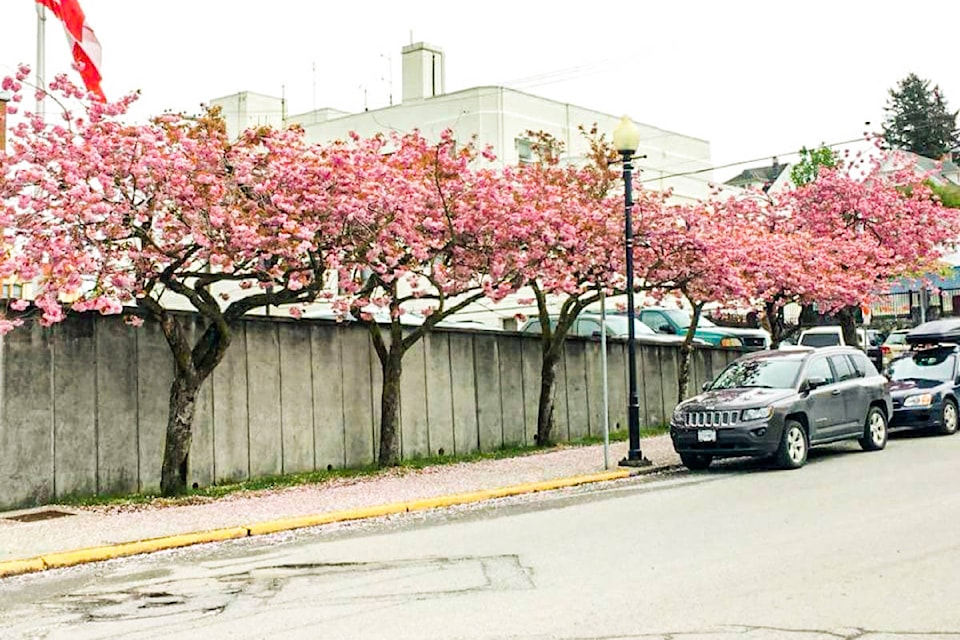Seventy-six years to the day after Shotaru Shimizu was forced out of Prince Rupert on trains bound for internment camps, the cherry trees he gave as gifts to the city were nearly all cut down.
On Friday, March 23, Rupertites were shocked when they witnessed saws being taken to the cherry trees at the corner of Fourth Street and Second Avenue. So far, three of the seven trees next to the Department of Fisheries and Oceans buildings on that block have been removed, with no warning being given to the city.
READ MORE:
The spot was a favourite for many who enjoyed witnessing the beauty of the trees in full spring bloom or ate under their shade at lunch.
���߲��о����Those trees have been here longer than the people have been in office,���߲��о���� said Lorne Stewart, who was one of several observers voicing their displeasure. ���߲��о����I���߲��о����ve had my lunch break out there for years under the shade tree.���߲��о����
While many of the observers knew the trees had been there for a long time, none knew the story of Shotaru Shimizu, the Japanese immigrant who donated them to the city.
Shimizu, affectionately known by his friends as Tom, moved to Prince Rupert in 1905 to work on the Grand Trunk Pacific Railway. As was the case with many people in the city at that time, Shimizu was attracted to the potential of Prince Rupert as a gateway to Asia for North American goods.
When grand plans for Prince Rupert died with Charles Hays aboard the Titanic, Shimizu shifted his focus, opening a 30-room hotel and restaurant with a partner called the New Dominion on Third Avenue in 1917.
There with his young family, Shimizu built a business that flourished. Henry Shimizu, Shotaru���߲��о����s son, remembers doing chores in the restaurant as a child.
���߲��о����I was only 13 at the time, and the only thing I ever did was fold napkins for the various tables with my cousin,���߲��о���� Henry said. ���߲��о����We used to put them in a glass cup and we would put them on all the tables.���߲��о����
The New Dominion continued to be successful through the depression and in the early stage of the Second World War, as labourers came to the town to help build ships. Everything changed, however, when the Japanese bombed Pearl Harbour in 1941, and the country turned on its Japanese citizens.
On February 26, 1942 Shimizu was told that his family would be removed from Prince Rupert. On Monday March 23, 1942, Shimizu left the city on the very trains he had helped to build decades earlier.
Henry, now 81-years-old, remembers his classmates coming to see him at the train station before he left.
���߲��о����They thought I was going on a vacation or something, but I didn���߲��о����t have any idea where I was going,���߲��о���� he said.
The family spent approximately four years at an internment camp in New Denver. During that time, the hotel he built was seized and sold by the Custodian of Enemy Property. By the time they left the camp, the life they had built on the northwest coast was gone.
���߲��о����I remember an official saying that I was a Canadian-born, enemy alien, which never made any sense to me,���߲��о���� said Henry. ���߲��о����How can you be both Canadian and an enemy alien?���߲��о����
After leaving the internment camp in 1946, Shimizu moved his family to Edmonton where they started their lives over, but he remained fond of Prince Rupert despite the circumstances under which he left the city.
READ MORE:
���߲��о����He enjoyed Prince Rupert, and felt that he had prospered to some degree,���߲��о���� Henry said. ���߲��о����And he wanted to try and give something back for what he had received.���߲��о����
In 1959, Shimizu arranged for 500 Japanese cherry blossom trees to be imported into the country and planted at various locations in Prince Rupert including the cemetery, Port Edward School, the Miller Bay Indian Hospital ���߲��о���� and the newly constructed federal building at the corner of Fourth Street and Second Avenue. Private citizens also received trees for their personal gardens.
A year later, another 1,000 cherry blossoms were donated to the town, and Peter J. Lester, who was mayor of Prince Rupert at the time, expressed his gratitude for the gift in a letter dated May 4, 1960.
���߲��о����I wish to thank you once again for your generous gift of 1,000 cherry trees,���߲��о���� Lester said in his letter. ���߲��о����I think in time to come, when those trees are in bloom throughout the city, people will be even more appreciative than they are now.���߲��о����
Gregory Shimizu, Shotaru���߲��о����s grandson, said his grandfather was beginning to lose his sight when the donations were being made, but he wanted to leave something that would last.
���߲��о����He was creating this thing that people could see that couldn���߲��о����t be taken away,���߲��о���� Gregory said.
Shimizu passed away in 1981, far from the city where he first made his life in Canada, and the trees he gave to make it more beautiful.
matthew.allen@thenorthernview.com
Like us on and follow us on



